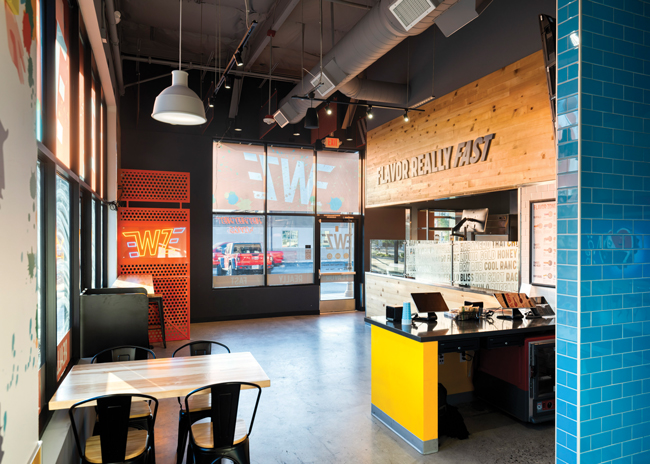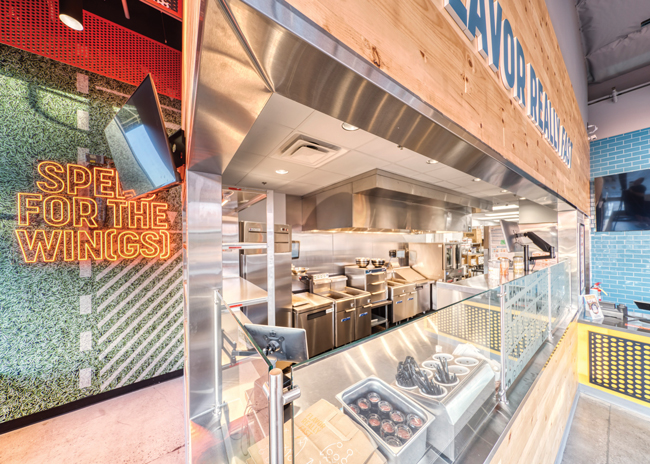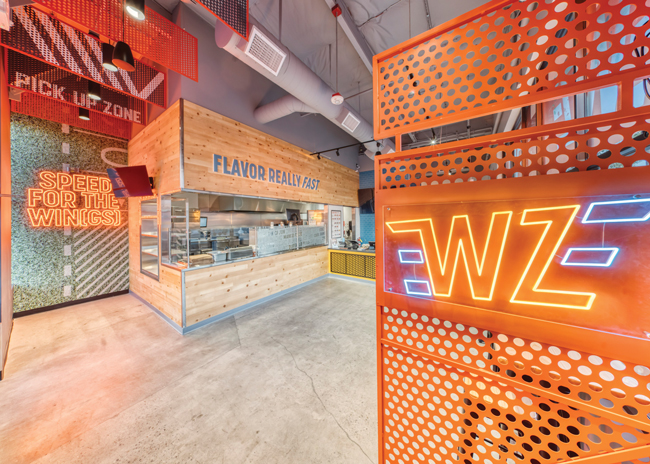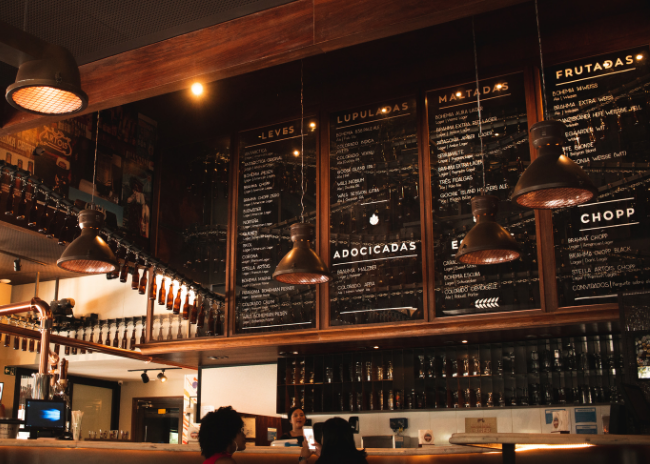 The new design features an expanded seating area. With a two-minute cooking process, these areas are utilized frequently during the lunch hour.Good luck trying to order wings on Super Bowl Sunday. Wait times can easily stretch past three hours. But, even on a normal night, it can take an hour and a half or more to get wings delivered.
The new design features an expanded seating area. With a two-minute cooking process, these areas are utilized frequently during the lunch hour.Good luck trying to order wings on Super Bowl Sunday. Wait times can easily stretch past three hours. But, even on a normal night, it can take an hour and a half or more to get wings delivered.
The culprit is cooking time, says David Bloom, chief operating officer and chief development officer for Capriotti’s Sandwich Shop and Wing Zone, which was acquired by Capriotti’s in late 2020.
According to Bloom, a batch of wings usually takes 10 to 12 minutes to cook. While that’s not too bad on its own, “the problem is if the first batch is 10 or 12 minutes, the second is 20 minutes and the third is 30 minutes,” he says.
When Capriotti’s acquired Wing Zone, solving this problem became the centerpiece of the wing chain’s new strategy and, eventually, its new design.
 Dividers in pigskin orange are just one element that connects the chain’s new design to sports. Images courtesy of Wing Zone
Dividers in pigskin orange are just one element that connects the chain’s new design to sports. Images courtesy of Wing Zone
Why Wing Zone?
By the late 2010s, Capriotti’s was posting record revenues, profitability and store growth. With strong operations and a committed group of franchisees, the chain began looking for an acquisition target. In Wing Zone, it found a concept that checked the most important boxes.
Operationally, the two brands align well, says Bloom. Like the sandwich chain, Wing Zone is a fast-casual concept with a heavy off-premises business. The two concepts also have similar footprints, start-up costs and per-store revenues.
With a limited number of national players in the fast-casual/QSR wing space, Wing Zone also had room to grow.
This natural fit and growth potential were complemented by what Capriotti’s could offer the Wing Zone concept. Compared with Wing Zone, Bloom says, the sandwich chain had a more robust marketing team and more sophisticated technology in the form of POS systems, employee training and more. There was clearly opportunity, he says.
Wing Zone’s new leadership didn’t just apply its own systems to the chain and stop there, though. The chain hired restaurant consultancy Livit, out of Madrid, to help it analyze practically every aspect of the chain, from kitchen design and operations to branding to front-of-the-house look and feel, to help find Wing Zone’s biggest opportunities.
Wing Zone leadership and Livit were soon asking what, exactly, the chain could offer that other wing places couldn’t. Their answer: speed.
“[Wing Zone] was one of the first brands to introduce a wide variety of flavors,” says Bloom. “They were very early on in that, but that is no longer a differentiator because lots of people have that. They were also a very early adopter of delivery, but obviously lots of people deliver. What we really felt we could be great at was getting the wings to you, getting the product to you fast… We wanted to settle on a cooking process that would allow us to get the wings out of the kitchen in literally just a few minutes.”
 The open kitchen allows Wing Zone employees to interact with guests who are picking up to-go orders or ordering via kiosk.This was no small task. In fact, it took a full year for Wing Zone to nail down its new wing production process. During this process, the chain tried practically every cooking method out there, from sous vide to grilling to smoking to baking at various times and temperatures, says Bloom.
The open kitchen allows Wing Zone employees to interact with guests who are picking up to-go orders or ordering via kiosk.This was no small task. In fact, it took a full year for Wing Zone to nail down its new wing production process. During this process, the chain tried practically every cooking method out there, from sous vide to grilling to smoking to baking at various times and temperatures, says Bloom.
Wing Zone finally hit upon a three-step cooking process that starts with a low-temperature bake in olive oil a day or so prior to serving, pre-frying the day of, then flash frying when orders come in. With this approach, Wing Zone can get an order of wings out of the kitchen just two minutes after receiving an order. What’s more, the quality has actually improved, Bloom says. “We were not just looking to get food out fast, but we wanted a better product,” he says. “By baking at a low temp in olive oil the way we are, the wings maintain their size and their juiciness versus frying them for 10 or 12 minutes. It’s a much-improved product.”
A better cooking process is one thing, though. Making the most of this process is another. To take advantage of this new cooking method, Wing Zone created a whole new restaurant prototype, complete with a fresh kitchen, interior design and branding strategy.
Built for Speed
Visit one of the pre-acquisition Wing Zone restaurants, and you’ll find a broad menu. Not only can you get wings and tenders, but also hamburgers, chicken sandwiches, wraps, salads, fried shrimp, quesadillas and multiple desserts.
That’s not the case at the new restaurants. The chain’s redesign is built for a much simpler set of offerings: bone-in and boneless wings, chicken tenders, french fries and one dessert. According to Bloom, the items on this more focused menu account for the vast majority of sales at legacy stores.
By simplifying the menu to its core elements, then, Wing Zone was able to develop a streamlined kitchen focused on its core differentiator of speed. This involved eliminating pieces like a flattop — no longer needed with the new menu — as well as establishing a flow of work from the back of the restaurant to the front. The chain even specified elements like the exact location of items in cold storage and the use of speed racks to make moving wings to the production kitchen quicker.
Speed wasn’t the only factor in the kitchen’s design. The Capriotti’s brand has an established relationship with a kitchen robotics manufacturer. The company’s leaders expect robotics to play a bigger role in foodservice in the coming year, so the Wing Zone kitchen is set up to accommodate a robot wing cook when the time comes.
 The chain’s connection to sports extends to activity and fun through custom art like this wall graphic.
The chain’s connection to sports extends to activity and fun through custom art like this wall graphic.
Communicating Fast
Designing a kitchen for speed and efficiency was one part of the puzzle. The other was helping customers understand this speed — and creating a more welcoming atmosphere in anticipation of their reaction.
To that end, the chain’s leadership gave Wing Zone a new logo that offers a sense of movement, along with a new tagline, “Flavor Really Fast.” Both were introduced earlier this year in a new restaurant in North Las Vegas, Nevada, not far from the Capriotti’s/Wing Zone headquarters in Las Vegas.
This new Wing Zone restaurant is company-owned, the first such store in the Wing Zone system. “One thing we believe in as a company is owning and operating a significant enough number of company shops to be really good at the business we are franchising,” says Bloom. “We believe in doing all the testing and risking our own capital before asking anybody else to bet on a new design or bet on a new product or technology or process.”
The new restaurant communicates Wing Zone’s brand proposition from the outside, with the new logo and tagline on display. From the exterior, fast “is the one message we want you to get. That is what we are going for,” Bloom says.
Entering the restaurant, guests find several zones in the 1,400-square-foot space. The first they encounter is the pickup area for to-go orders. The chain considered a number of options for storing to-go orders and settled on open shelves under heat lamps. This solution, says Bloom, helps keep wings warm and crispy while also accommodating different-sized orders. “People might be ordering a combo just for themselves, or they might be ordering 150 wings,” he says. “Those open shelves give us flexibility while giving us the look we want.”
The space’s design elements include a metal cloud feature (color: pigskin orange) that helps define the pickup zone, as well as a football field wall graphic with a neon “Speed for the Wings” sign. This wall graphic does more than reinforce the well-known wings-and-sports connection. It’s also part of a pending virtual reality feature that will let guests place themselves in a virtual setting/Instagrammable moment via the chain’s app, Bloom notes.
Wing Zone’s focus on sports is intentional, but not overwhelming, Bloom stresses. Other art elements include brand messages focusing on flavors and wall graphics featuring stylized drawings of people playing everything from flag football to video games. “You still get that sports feel [in the new design], that active life feel because that is still a big part of the business,” he says. “We certainly didn’t want to abandon the core customer, but we wanted to expand the pool — the age groups and the type of people that are comfortable walking into a wing restaurant.”
Wing Zone’s approach is an important part of its future. With two-minute wings, the chain can be a place people think of beyond sports, as well as a realistic lunch spot, adds Bloom. Legacy Wing Zone locations, he notes, don’t do much lunch or dine-in business. Anticipating more lunch traffic thanks to its fast service, Wing Zone designed this new restaurant with 18 seats. Furnishings are made with metal frames, wooden seat bottoms and butcher block tables.
These materials, along with a stained concrete floor, pigskin orange dividers and light blue subway tiles, are meant to create a space that’s fun but also welcoming to customers of all ages and levels of interest in sports, Bloom says.
A third zone in the restaurant contains the open kitchen and POS station. The POS technology Wing Zone put in place can function as a traditional POS or can be flipped toward the customer to work as a self-order kiosk. When guests enter, a greeter can welcome them and direct them to the kiosk or take their order if needed.
The open kitchen is just to the left of the POS and connects directly with the to-go shelves. The chain decided to open the kitchen to show guests that their wings are being cooked and tossed to order. Just as important is the personal connection this setup allows. “We want our employees to be able to interact with a customer, especially as we are implementing robotics and other technologies in the back of the house. We want to make sure that the customer service, the warm greeting when you walk in, is still there,” says Bloom.
The open kitchen introduced its own challenge to the design. A restaurant specializing in fried food can quickly smell a lot like fried food. This was a particular concern with the chain’s simultaneous investment in dine-in. To counteract that smell, the chain has installed odor neutralizers. With the help of Livit, it’s also infusing the restaurant with a spicy scent that complements chicken wings.
Similarly, Wing Zone has invested in its audio system. The chain’s “sonic strategy” adjusts to the daypart, matching the music with the mood it wants to create for guests and employees. “What’s the tempo of the music, the energy of the music you want during setup and prep? What do you want during lunch, what kind of music do you want playing during peak [hours] and even during the closing to energize the employees? We took a deep dive into all of those,” says Bloom.
 The “Flavor Really Fast” branding relies on new cooking processes and a trimmed-down menu.
The “Flavor Really Fast” branding relies on new cooking processes and a trimmed-down menu.
Flagship or Not?
While this store has been labeled a flagship, Bloom is quick to say it’s not a finished product. The chain has learned several lessons that will make their way into the design of coming restaurants.
One big lesson involves lunch and dine-in. Both are doing better than Wing Zone expected, so the seat count in future restaurants will likely be higher than 18, says Bloom. Other changes involve the equipment package. The chain will likely add space to the saucing station and prep area, and will adjust the walk-in sizes, for instance.
Overall, though, Wing Zone is pleased with the performance of this first “Flavor Really Fast” location. Next steps include determining what makes sense to roll out to legacy locations.
The company, Bloom stresses, is not going to make franchisees of older restaurants change their business just for change’s sake. For the most part, no changes will be required, and any new elements introduced into legacy stores must directly enhance the business. Elements without a clear payoff won’t be required of Wing Zone’s partners.
“Now that we are starting to see [how the new store performs], we’re going to go back to them and say, ‘Hey, we’ve got this. It’s working really well,’ whether it is a new cooking process, a new POS system or a new marketing program,” Bloom says. “We will do it piece by piece. We are not looking to radically rip things out and make changes.”
New franchised restaurants, though, will have the new Wing Zone menu and design. The chain, says Bloom, is targeting 250 total units by 2025. About 150 units are in the development pipeline at this time.
To get to 250, Wing Zone is not focusing on specific markets. Instead, it is looking for good partners first. In addition to business acumen and financial requirements, the chain prioritizes a good cultural fit. Franchisees, Bloom says, need integrity, genuineness and a passion for success.
The chain, of course, is banking on new franchisees being drawn to the chain’s value proposition. While competing brands also offer off-premises dining and a variety of sauces and rubs, Wing Zone believes it has hit on a true differentiator in the wing space with speed of service.
If the chain does gain traction with this approach, the year spent developing a faster cooking method and a restaurant around that method will have been worth it.
“We thought we could deliver on [flavor], improve on the product’s quality a little bit and certainly improve on efficiency,” says Bloom. “We thought If we could get hot food with great flavor to the consumer really fast, then we would win.”

Snapshot
- Project team: Livit Design and Capriotti’s
- Headquarters: Las Vegas
- Concept owner: Capriotti’s
- Concept: Fast-casual chicken wings and tenders
- Unit count: 70
- Average check: $26.00
- Location of new prototype: North Las Vegas
- Opened: July 11, 2022
- Size: 1,400 square feet
- Real estate (in-line, endcap, etc.): Endcap
- Design highlights: Open kitchen and the use of technology and updated cooking methods to deliver on the “Flavor Really Fast” brand promise
- Build-out time: 6 months



